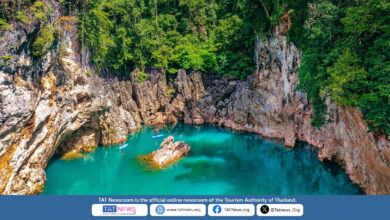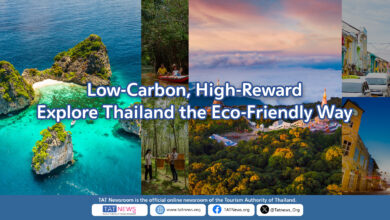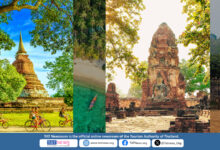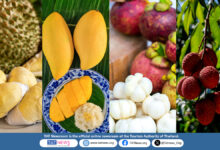Thailand’s northernmost province of Chiang Rai, bordering Myanmar to the north and Lao PDR. to the east, boasts a dramatic landscape of mountains, rivers and forests, an ethnic diversity in its people including those of hilltribe and Chinese lineage, and a strong Lanna identity that can be seen in its architecture, art, language, music and cuisine.

While the cultural essence of this identity – which dates back to Chiang Rai’s founding in 1262, and its role as the second capital of the Lanna Kingdom – is very much retained, there is also a growing modernisation of this taking place, one that offers a new perspective of Lanna in the contemporary world.
Chiang Rai found itself thrust onto the global stage in June and July of this year, when the Mu Pa or Wild Boars football team of 12 young boys and their coach became trapped by rising flood waters in Tham Luang Cave in Tham Luang-Khun Nam Nang Non Forest Park. The multinational operation that successfully rescued them gripped Thailand and the world, and memorials created to honour the epic mission have become new attractions in Chiang Rai.
Not least of these is a museum at Wat Phra That Doi Wao in the province’s northernmost district of Mae Sai, the temple where the boys were ordained as Buddhist novice monks for nine days to make merit for Lt. Cdr. Saman Gunan, the former Thai navy Seal diver who died while assisting in their rescue. Here, there are some 5,000 photographs of the cave rescue operation on display.
At Wat Rong Khun, also known as the White Temple, about five kilometres from Chiang Rai city is an enormous painting by a team of artists led by national artist Chalermchai Kositpipat depicting the rescue mission and the key figures involved, as well as a life-sized statue of Lt. Cdr. Saman created by a team of Northern artists led by Sarayuth Kammoonchai.

The White Temple is the creation of Chiang Rai-born Chalermchai and represents an unconventional approach to temple architecture, fusing as it does elements from the artist’s own imagination with orthodox Buddhist teachings about heaven, hell, karma and earthly sins. The temple is full of Buddhist symbolism while Chalermchai has also used icons from modern culture; such as, spaceships and even Neo from the Matrix movies to tell stories of the Buddha’s life and teachings.
As well as the White Temple, there is also the Black House and the Blue Temple, all of them fascinating representations of the new creative movement in Chiang Rai that is blending modern art and architecture with the ancient philosophy of Buddhism.
Baan Dam, or Black House, is 10 kilometres north of the city centre and is the labour of love of another national artist, the late Thawan Duchanee. Painted all in black, the compound is as playful as it appears grim, with animal hides and bones, eerie sculptures and tribal statues among the displays it houses.
The Blue Temple, or Wat Rong Suea Ten, is a 10-minute drive from the city’s Night Bazaar area and was completed in 2016. Adorned in the colours of sapphire blue and gold, the temple’s artwork and structure exude a modern feel, while the exterior features carved statues of the Buddha, Nagas, Garuda and other beings from Thai Buddhist cosmology.
There are of course traditional temples that can be visited, among these Wat Klang Wiang in the city centre, which houses the original city pillar shrine; Wat Phra Kaeo, which is the original site where the Emerald Buddha now in Bangkok was enshrined, and Wat Phrathat Doi Chom that sits atop a low hill overlooking the entire city.
Among the city’s notable attractions is the Chiang Rai Clock Tower. Designed by the same Chalermchai behind the White Temple, the Clock Tower puts on a light show every evening at 7, 8 and 9 p.m. Not far away is the King Mengrai the Great Monument, which stands in proud testimony to the founder of the Lanna Kingdom.

The central city area is also where Chiang Rai’s very own Saturday Night Walking Street takes place. Here, from 4 p.m. onwards, market-goers can peruse Lanna antiques, OTOP (One Tambon One Product) goods, locally made handicrafts and traditional knowledge products; such as, spa, herbal and massage items.
For those who happen to visit Chiang Rai during the New Year period, the annual Chiang Rai Flower Festival is well worth checking out for the myriad of different plants and flowers on show like roses, orchids and tulips to name but a few. The event also features plant contests, flower processions and cultural performances.
Not far from the city are attractions like Singha Park and Rai Chern Tawan Meditation Centre, which make for great day excursions. Further afield are attractions like Choui Fong Tea Plantation, where visitors can see first-hand how tea is grown and which is perhaps best visited as a stopover on the way to the Thai-Myanmar border town of Mae Sai or Doi Tung home to the Mae Fah Luang Garden and Wat Phrathat Doi Tung that sits at an altitude of nearly 2,000 metres above sea level.
Singha Park is about 12 kilometres from the city centre and is agro-tourism focused with various activities on offer from a petting zoo the kids will love to rock climbing and zip lining for the adventurous to pleasant pathways adults will appreciate strolling along. The Park is large and the bicycles for hire onsite are a great way to explore it, while there is also an electric tram that tours the various sights.
Roughly 20 kilometres from the city, Rai Chern Tawan Meditation Centre is a quiet retreat set in peaceful surroundings with bungalow and tent accommodation, where all are welcome to come and study Buddhist dhamma and reflect upon life.
For an interesting insight into Chiang Rai’s history and its Lanna cultural heritage, Mae Fah Luang Art and Cultural Park and Oub Kham Museum are both just a few kilometres from town, while centrally located in town is the Hilltribe Museum and Education Centre, which is a recommended visit (beforehand) for tourists planning to travel to the region’s hilltribe villages. The Centre was created to educate tourists about the six major tribal groups of Northern Thailand – the Akha, Hmong, Karen, Lahu, Lisu and Yao, their culture and on etiquette they should observe when visiting the villages.
Tourists lucky enough to visit when the annual Akha Swing Festival is held – usually around August or September in the rainy season – are in for a real treat. One of the most important festivals for the Akha hilltribe people of Chiang Rai, this colourful and vibrant event commemorates the goddess of fertility, celebrates an abundant crop to be harvested, and honours the Akha women. For them, it is an opportunity to wear the costumes and ornaments they have made during the year and to show they have entered marriageable age.
A highlight of the Akha Swing Festival is when the women ride a giant bamboo and wooden swing at frightening heights, often at the edge of a cliff, while singing, laughing, screaming and reciting Akha verses.
A couple of hours’ bus ride from Chiang Rai city is Chiang Saen, on the banks of the mighty Mekong River and Thailand’s oldest city boasting an impressive history. It was a main city of the ancient Lanna Kingdom and the capital before Chiang Rai’s establishment in 1262. Evidence of these former glory days can still be seen today in the form of chedis, Buddha images, earthen ramparts and pillars.
Chiang Saen is also famed for its vantage points looking out over the Golden Triangle, where the borders of Thailand, Lao PDR. and Myanmar come together at the convergence of the Khong and Ruak Rivers.
As northernmost province Chiang Rai serves as a strategic gateway for air and land travel with neighbouring countries in the region like Lao PDR. and Myanmar. Destinations further afield like Hong Kong are also connected with direct flights into the Mae Fah Luang-Chiang Rai International Airport.
Chiang Rai is one of 55 secondary destinations the Tourism Authority of Thailand is promoting through the “Amazing Thailand Go Local” campaign, the aim being to spread the tourism revenue more into rural areas and grow community tourism in a responsible and sustainable manner, while also evening out seasonality and weekend/weeday travel flows.




























